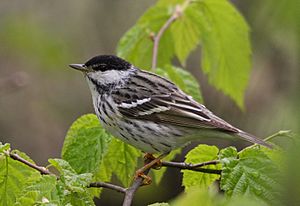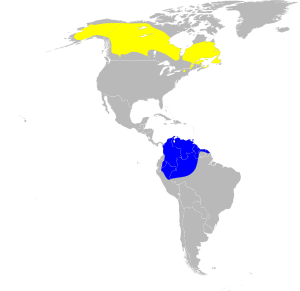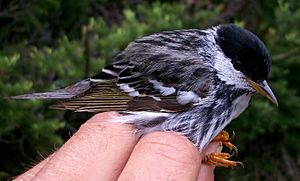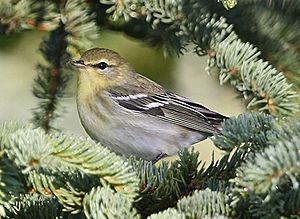Blackpoll warbler facts for kids
Quick facts for kids Blackpoll warbler |
|
|---|---|
 |
|
| Conservation status | |
| Scientific classification | |
| Genus: |
Setophaga
|
| Species: |
striata
|
 |
|
| Range of S. striata Breeding range Wintering range | |
| Synonyms | |
|
Dendroica striata |
|
The blackpoll warbler (Setophaga striata) is a small songbird found in the New World. These birds are known for their incredible long-distance migrations. Breeding males are mostly black and white. They have a clear black cap on their head, white cheeks, and white stripes on their wings.
Blackpoll warblers breed in the northern forests of North America. You can find them from Alaska across most of Canada. They also live in the mountains of New York and New England. They are a common migrant across much of North America.
In the fall, these amazing birds fly south. They travel to the Greater Antilles and the northeastern coasts of South America. This journey is a non-stop flight over open water. It averages about 2,500 kilometers (1,550 miles). This makes it one of the longest non-stop overwater flights ever recorded for a songbird! Sometimes, they even wander to western Europe.
Contents
What's in a Name?
The name Setophaga comes from Ancient Greek words. Ses means "moth" and phagos means "eating." So, it means "moth-eating." The second part of its scientific name, striata, means "striped." This refers to the stripes on the bird's body.
What Do They Look Like?
The blackpoll warbler is a fairly small bird. It weighs about as much as a ballpoint pen! It is one of the larger birds in its group, called Setophaga. These birds are usually between 12.5 to 15 centimeters (5 to 6 inches) long. Their wings can spread from 20 to 25 centimeters (8 to 10 inches) wide.
Most blackpoll warblers weigh between 12 and 15 grams (0.4 to 0.5 ounces). Summer male blackpoll warblers have dark-striped brown backs. They have white faces and black caps. Their undersides are white with black stripes. They also have two white bars on their wings.
Adult females look similar to males but are less brightly colored. Their heads and faces are usually gray. A special feature of this bird is its bright orange or pink legs. Young birds have greenish heads and yellowish chests. Their wing bars are always visible.
Where Do They Live?
In the southern parts of their breeding areas, blackpoll warblers live in high mountain woodlands. They also spend their summers on wooded islands along the coast of Maine and Canada. Farther north, they live in thick evergreen forests. Blackpolls breed closer to the cold tundra than any other warbler.
How Do They Behave?
Blackpoll warblers can be hard to spot. They often sit quietly in dense leaves high up in trees. They are more often heard than seen. Their song is one of the highest-pitched bird songs known. It sounds like simple, repeated "tsi" notes. Their calls are thin "sit" sounds.
What Do They Eat?
Blackpoll warblers mostly eat insects. They move slowly when they look for food. Sometimes they will quickly fly or hover to catch insects. They eat many different kinds of adult insects, insect larvae, and spiders.
Some of their favorite foods include lice, locusts, mosquitoes, ants, and sawflies. They also eat berries during their migration and in winter. They often catch insects while flying.
How Do They Reproduce?
Blackpoll warblers build their nests in evergreen forests, especially those with spruce trees. Their breeding areas reach into the cold northern forests called the taiga. They usually build their cup-shaped nests low in a conifer tree.
Females lay 3 to 5 eggs, but sometimes up to 9. The eggs hatch in about 12 days. The young birds leave the nest when they are only 10 days old. At this age, they cannot fly very well. Their parents feed them for about two weeks. Females often start a second nest right away. The male then takes care of the first group of young birds.
Amazing Migration!
The blackpoll warbler's flight across the ocean has been studied a lot. Scientists use radar, bird banding, and other methods to learn about it. It is not known if they eat insects during their long flight.
Blackpoll warblers have the longest migration of any New World warbler. This is why they are one of the last warblers to appear in spring. They arrive in North America from early May to mid-June. Most other warblers are already on their breeding grounds by then.
In the fall, these birds fly from their northern breeding areas. They gather in the northeastern United States starting in mid-August. Most blackpolls fly directly over the Atlantic Ocean to their winter homes. These homes are in Puerto Rico, the Lesser Antilles, or northern South America.
To make this flight, the blackpoll warbler almost doubles its body weight. They eat a lot to store fat for energy. They also use strong winds to help them fly. When they fly south over the Atlantic, they burn about 0.08 grams of fat every hour. This ocean flight is about 3,000 kilometers (1,860 miles) long. It can take 72 to 88 hours without stopping! They fly at a speed of about 27 miles per hour (43 km/h).
Blackpolls can weigh over 20 grams (0.7 ounces) when they leave the United States. They can lose 4 or more grams by the time they reach South America. Some birds stop in Bermuda before continuing their journey. Sadly, some birds, especially those with less body fat, do not make it.
In 2013, scientists put tiny tracking devices on 37 blackpolls. These devices recorded light levels to estimate their location. In 2014, five of these birds were found. Four of them left Nova Scotia between September 25 and October 21. They flew at speeds between 10.7 and 13.4 meters per second. The study showed that their spring migration (over land) and fall migration (over water) were very different. When comparing flight distance per body mass, blackpolls are among the top long-distance travelers. Only the ruby-throated hummingbird might travel more kilometers per gram.
Images for kids
-
A migrating adult in a fruiting flowering dogwood tree
See also
 In Spanish: Reinita estriada para niños
In Spanish: Reinita estriada para niños





